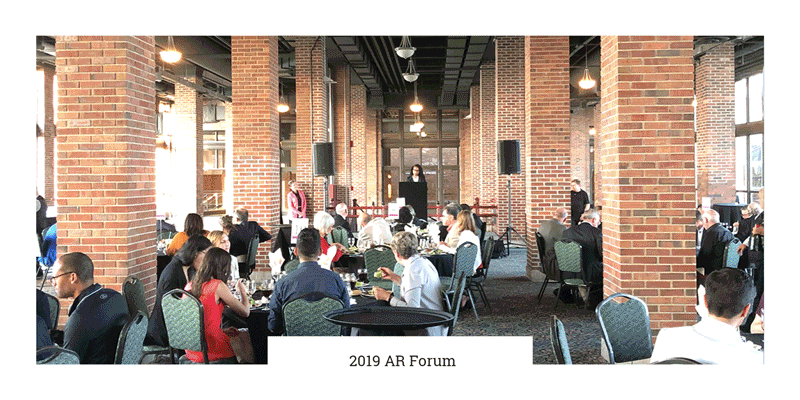The ACSA Board of Directors met in July alongside the boards and appointed representatives of the other four collaterals, AIA, NCARB, NAAB, and AIAS, as well as the Presidents of NOMA and the CCCAP to provide feedback on the 2020 conditions and procedures for accreditation. Bruce Mau provided a thought-provoking keynote to launch the three-day Accreditation Review Forum (ARForum19), reflecting on the critical ways in which design shapes the world around us. Mau challenged the group to think bigger, in consideration of the health, safety, and welfare of all livings things, not just humans. He also reflected on the rapid pace of societal changes and the mandate to prepare students to engage in this unpredictable context during the span of their careers.
Mau’s words provided a fitting foundation for the next two days of meetings. However, the planning process for ARForum19 began over a year earlier through the formation of the Steering Committee and Task Force. Comprised of representatives from all five collaterals, these committees collectively authored “Draft 0” of the new conditions and procedures for accreditation that were released for public comment in May 2019. On behalf of the ACSA Board of Directors, I would like to express my appreciation to Bruce Lindsey, Rebecca O’Neal Dagg, and Michaele Pride for their work on the Steering Committee and John Cays, Tom Fisher, and David Hinson for their contributions to the Task Force. The committees sought to advance the accreditation process by promoting excellence and innovation; allowing greater flexibility; encouraging program distinctiveness; supporting equity, diversity, and inclusion; increasing access to the profession; stimulating the generation of new knowledge; and protecting the public interest.
The “Draft 0” documents propose numerous and substantial changes to the accreditation process for architecture schools. Most notably, Realms and SPC have been replaced with Program Accreditation Criteria and Student Accreditation Criteria, with significant revisions to the evidence requirements for student work. Evidence would no longer be required for criteria at the level of “understanding.” In its place, programs would submit course materials such as syllabi, tests, etc. as documentation. These materials would be provided to the visiting team 45 days before the visit with the potential of shortening the in-person visit by a day. The conditions also place greater emphasis on self-assessment processes in lieu of student evidence. In addition, the terms for continuing accreditation would also change, eliminating the four-year term, and two and five-year interim progress reports. Under the proposed procedures, schools would receive an eight-year term if all conditions have been met, or an eight-year term with a plan to correct, requiring programs to address any deficiencies within three years.
ACSA received numerous detailed comments on the “Draft 0” documents, which were shared with the NAAB and discussed by the board prior to accreditation conference. (Refer to this link for ACSA’s response.) The comments generally focused on the cohesiveness, consistency, and clarity of expectations and requirements of programs. During the forum meetings, the ACSA board and representatives engaged in productive dialogue with the other attendees to provide feedback to the NAAB as it prepares for the release of “Draft 1” of the standards, expected to be available in early September. ACSA will host a workshop to discuss the new documents at the Administrators’ Conference in New Orleans on Thursday, November 7, 2019. The public comment period for the next draft will end a few weeks later on November 22, 2019. Please take time to review the draft conditions and procedures and share your feedback with ACSA. We value your input.
Through the convening of the full boards of all five collaterals in architecture, ARForum19 provided a meaningful opportunity to achieve short-term outcomes while also engaging in long-term visioning. In addition to the feedback shared on the accreditation documents, we also responded to Bruce Mau’s prompt to think bigger and to consider the collective goals and ambitions that we share for the future of architecture. The next meeting of the Presidents of the five collaterals in October 2019 will be dedicated to prioritizing and advancing many of the long-term shared goals identified in the meeting.
I would like to thank Kevin Flynn, NAAB President, and Helene Combs Dreiling, Interim NAAB Director, for their leadership and efforts to ensure the success of the forum, and for their dedication to the advancement of architecture education.
Rashida Ng, ACSA President

 Study Architecture
Study Architecture  ProPEL
ProPEL 
